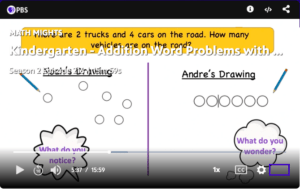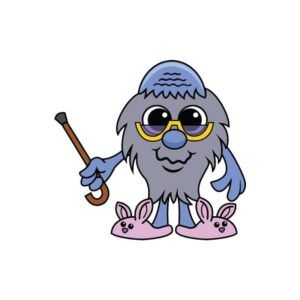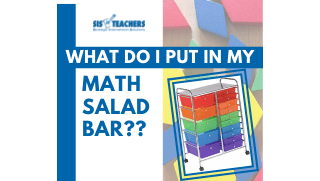So which shows have you watched? Have you watched it with your students in your classroom? Are you a parent and have played it for one of your children? Have you been able to download it for a grandchild? We would love to hear how things are going!
 Last week was a great second week, getting word out about the Math Mights Show! In Michigan, there are about six different channels that will be hosting it, and about half of those have gotten up and running. The Michigan Learning Channel is starting to pick up some speed, and of course, we have a ton of resources for you on our https://mathmights.org website!
Last week was a great second week, getting word out about the Math Mights Show! In Michigan, there are about six different channels that will be hosting it, and about half of those have gotten up and running. The Michigan Learning Channel is starting to pick up some speed, and of course, we have a ton of resources for you on our https://mathmights.org website!
M³ (Molding Math Mindsets) members! Make sure you go in and download that PowerPoint that goes along with each show! Maybe you haven’t gotten to the lesson yet depending on your pacing. Maybe you’re getting ready to teach it, or you’re not quite there yet. Either way, save the PowerPoints in a folder and you’ll have a library of interactive lessons ready to go for in-person teaching, virtual/online learning, or a hybrid situation!
(valid M³ Membership login required)
Teacher's Guide
Episodes 215-216
January Focus: Numeracy Talks
The theme of numeracy talks continues in all shows, K-3, with a bit of a change this week – what happens if someone answers incorrectly? How do we respond if someone gives the wrong answer in the numeracy talk? In Math Practice 3, we have the idea of constructing viable arguments and critiquing the reasoning of others, so we’ll have a chance to apply the second half of that practice in the numeracy talks this week.
Look for specifics about number talks by grade level in the corresponding section below.
Kindergarten

Focus: 215: Addition Word Problems: Part 2 / 216: Addition Word Problems with Quick Draws
“I Can” statement: I can use objects or drawings to show that I can solve addition word problems up to 10.
Extension Activity: “In the Barn” and “In the Sandbox” work mat and problems
For numeracy talks, we want kids to be able to envision how many they saw, take a picture of it instead of counting it, and be able to tell us what is one less or one more than what they saw.
The word problem adventure continues in both episodes 215 and 216.
 In 215, we get kids launched into the idea of the lesson by having them picking their favorite pet and thus collecting data to show that numbers aren’t just an abstract thing, but that they relate to things around us. Additionally, we want to show students that they can use numbers to make mathematical decisions about the things we’re thinking of.
In 215, we get kids launched into the idea of the lesson by having them picking their favorite pet and thus collecting data to show that numbers aren’t just an abstract thing, but that they relate to things around us. Additionally, we want to show students that they can use numbers to make mathematical decisions about the things we’re thinking of.
When working with word problems, we are trying to get kids to dive into a story and really act it out. In this show, we really spend a lot of time trying to help kids understand the concept of Quick Draw. This is the idea that, if the story is about bananas, we don’t actually have to draw bananas. We can do circles! It would take us way too long to draw five bananas and then show three more bananas. And so we spend a lot of time doing different kinds of quick draw scenarios with kids, for example, being on a farm and thinking of four pigs and three sheep, how many animals are there in all?
When we’re going through this process, we’re going through CPA – Concrete, Pictorial, Abstract. We’re giving kids a map that is depictive of the scene that we’re talking about to help them relate and interact with the story. We’re using the two sided counters for students to act it out. We’re doing that quick draw, and then we’re starting to bring in the idea of a number sentence. There are several wonderful mats included in the extension, including a barn scene, that kids can download and take home to help them really extend the idea of acting out story problems
In show 216, one of the scenes that we have is a street with both trucks and cars on the road. Now that kids understand the quick draw, that we don’t have to draw all the trucks and cars, we want to guide them into an organized drawing. This means that we don’t draw random circles everywhere, but we draw them in an organized, predictable pattern in our workspace. This will help with comparison, which we do a lot of in this episode.
 For this concept, Illustrative Math uses a simple partition line to keep the quick draws organized, which I love. So, if there are two trucks and four cars on the road, how many vehicles are on the road? We draw two circles to represent the two trucks, draw the line, and then you have four circles after it. We want the kids to be able to apply that! This helps them dive into the story and see what a pictorial representation would look like. We also have a frog story problem, where kids have to pick out which frog picture (with the partition line) quantitatively matches what we’re talking about. Finally, we start to introduce the number bond, helping students see the total and the part and the part.
For this concept, Illustrative Math uses a simple partition line to keep the quick draws organized, which I love. So, if there are two trucks and four cars on the road, how many vehicles are on the road? We draw two circles to represent the two trucks, draw the line, and then you have four circles after it. We want the kids to be able to apply that! This helps them dive into the story and see what a pictorial representation would look like. We also have a frog story problem, where kids have to pick out which frog picture (with the partition line) quantitatively matches what we’re talking about. Finally, we start to introduce the number bond, helping students see the total and the part and the part.
First Grade

Focus: 215: Adding 2-Digit Numbers / 216: Ten More, Ten Less
“I Can” statement: I can understand that adding 2-digit numbers means I add the tens then the ones. / I can find 10 more or 10 less in my head.
Extension Activities: Adding with Value Pak, Ten More, Ten Less Game
Our number talks in these episodes will be working on conservation to 20 with the double 10 frame mat. Like in Kinder, we’re going to ask about more or less, but at a higher level – What would be two less? What would be two more?
In 215, the “I Can” statement means students can add two-digit numbers by adding the 10s and then the 1s. We invite students into this lesson by having them look at different statements to see if they’re “balanced.” Ex. 80 + 5 = 5 + 80 Is that statement true? Is it false? Explain.
We introduce Value Pak in these particular lessons because it really helps the students see the value of a number as they’re looking at this kind of statement – 70 + 1 = 80 + 1. If you map those statements out with hide zero cards or place value strips, which Value Pak represents, it really helps kids get a conceptual understanding.
We also move into the idea of building a number with unifix cubes – adding the 10s and then the 1s, but we always want to build things in multiple modalities for kids to see. You’ll see a pattern with the problems here – and there is research behind it – we have a decade number plus a two-digit number. For example, 37 + 20, 50 + 23, 60 + 23. We bring back the abacus here because it is a great way to represent our pattern of decade number + two-digit number. It helps kids see how those quantities go together really well.
To practice this, the extension activity has a fun game called Adding with Value Pak. All the cards in the game help kids add a decade number with another two digit number that has something in the 1s and the 10s. It’s great to help kids start to feel more comfortable with adding larger numbers in first grade.
As we move into show 216 in first grade, again we have that numeracy talk but we’re focusing now on finding 10 more or 10 less, bringing in the subtraction or the addition. We ask kids to think about how they would solve different problems: 13 – 10? 15 – 10? The idea of multiple strategies is big here. One person might look at 13 like we do in numeracy talks, in the double-ten frame, and just think about taking away 10. Another student might think of what we already know with Value Pak and build 15 with the place value strips, decomposing to 10 and five, and then pulling that 10 out to get five. Getting kids to visualize this is really important. We start to bring in the idea of the base 10 blocks for students to visualize things like 67 plus 10. But what would it look like if it were 67 minus 10? The abacus also comes back again as another great way for kids to be adding 10 or taking away 10.
 For an extension activity, we have a game where students spin a number and have to record 10 more or 10 less, as well as explain their thinking to someone.
For an extension activity, we have a game where students spin a number and have to record 10 more or 10 less, as well as explain their thinking to someone.
If you have first graders who were ready to go further with this, we have a lot of resources about adding 10 and taking away 10 as you move into second grade that you could certainly use to extend this lesson up.
Ten More, Ten Less Lesson Bundles
Second Grade

Focus: 215 – Subtracting with 2-Digit Numbers / 216 – Subtraction with 2-Digit Numbers
“I Can” statement: I can subtract 2-digit numbers.
Extension Activity: Solve with D.C. and T-Pops
In number talks, we’re ramping up – adding a two digit plus a two-digit! We’re also narrowing it to just use D.C., even though we’re solving it more than one way. In this show we focus on the stem: “I agree with your results. Another way to solve it is…” Hopefully kids will be able to see that you can decompose either number.
Both 215 and 216 are on subtracting two-digit numbers, but the difference is that, in 215, we on doing so with a non regroup, but in 216, we look at problems where we do have to regroup.
I think it’s really important, with second grade students, to really practice the strategies of D.C. and T-Pops over and over and over again – without a regroup. Kids will often hear that saying “Go next door and borrow one,” but we don’t want to get kids to get that stuck in their heads. Instead, we want them to understand the value of numbers. In episode 215, D,C. and T-Pops battle it out, which is so fun! Kids get to see a non regroup problem, like 35 minus 23, or 35 minus 23 written more in a traditional fashion.

Towards the beginning of the show, we talk about how a student could determine if a problem is a regroup or a non regroup. It’s kind of fun because we do a side-by-side layout of D.C. decomposing, and then T-Pops doing it with the place value discs and the T-Pops Place Value Mat. What a cool visual for kids to see!
We do lots of different examples in this show, and then leave the students with a question to ponder…I wonder what would happen if we try to solve 53 minus 27? Obviously, this takes us into episode 216, which is going to help students learn how to answer that question.
 The big concept we want kids to understand is how D.C. decomposes by place value to subtract, which directly connects to how T-Pops solves using place value. The extension activity has four problems that will connect these two characters
The big concept we want kids to understand is how D.C. decomposes by place value to subtract, which directly connects to how T-Pops solves using place value. The extension activity has four problems that will connect these two characters
In show 216, we’re still subtracting two-digit numbers, but now with renaming or regrouping. Obviously we’re going to come back to this, as students will be doing larger numbers eventually, but for now, we have the students look at problems side by side, like 45 – 22 and 53 – 27. Students should notice that one problem is really easy, no regrouping necessary. But then, when we do have to regroup, how can we solve it with D.C.?
 This episode is great for students AND parents to understand regrouping in a new light. If I’m taking 53, yes, I can decompose it into five 10s and three 1s, but I really need to make it 4 10s and 13 1s. Again, we do a side-by-side comparison of D.C. and T-Pops solving the problem, but this time, focusing on renaming or regrouping. NOT borrowing! If I want to borrow your coat, you’d want it back at recess, right?? So we look at these two strategies and as kids if they can stretch their thinking and solve with both Math Mights!
This episode is great for students AND parents to understand regrouping in a new light. If I’m taking 53, yes, I can decompose it into five 10s and three 1s, but I really need to make it 4 10s and 13 1s. Again, we do a side-by-side comparison of D.C. and T-Pops solving the problem, but this time, focusing on renaming or regrouping. NOT borrowing! If I want to borrow your coat, you’d want it back at recess, right?? So we look at these two strategies and as kids if they can stretch their thinking and solve with both Math Mights!
There’s a really fun at-home or at-school extension for this one, where you get to solve the problem two ways (T-Pops and D.C.) with the regroup. Lots of fun stuff that kids can use with that and really be able to apply the strategy as they learn it.
Third Grade

Focus: 215: Relating Division to Multiplication / 216: Relating Multiplication and Division
“I Can” statement: I can find the answer to a division problem by thinking of the missing factor in a multiplication problem.
I can multiply and divide easily and quickly because I know how multiplication and division are related.
Extension Activities: Relating Multiplication/Division, Fact Flap Cards
 For 3rd grade number talks, in episode 215, we continue with subtraction of a two-digit number minus a two-digit number. In 216, we’ll go a little higher and have them do a three digit number minus a two digit number. In 3rd grade, we really want kids to be able to mentally solve subtraction problems. These problems are all written horizontally, not stacked vertically, which is really key if you’re doing a number talk with subtraction. Also, you’ll notice that these problems will all require a regroup, if you tried to solve them traditionally. This is on purpose! We want to push 3rd grade thinking into that open number line and hopping in friendly chunks. We’ll have students that will solve this problem two different ways – one of which will be less efficient, with students wanting to hop 10 at a time, but Springling can hop really far! She can hop from 50, all the way to 90, which is much more flattering to her fur!
For 3rd grade number talks, in episode 215, we continue with subtraction of a two-digit number minus a two-digit number. In 216, we’ll go a little higher and have them do a three digit number minus a two digit number. In 3rd grade, we really want kids to be able to mentally solve subtraction problems. These problems are all written horizontally, not stacked vertically, which is really key if you’re doing a number talk with subtraction. Also, you’ll notice that these problems will all require a regroup, if you tried to solve them traditionally. This is on purpose! We want to push 3rd grade thinking into that open number line and hopping in friendly chunks. We’ll have students that will solve this problem two different ways – one of which will be less efficient, with students wanting to hop 10 at a time, but Springling can hop really far! She can hop from 50, all the way to 90, which is much more flattering to her fur!
We want to help students understand how to find the answer to a division problem by thinking of the missing factor in a multiplication problem. “I can figure out 32 ÷ 8, because I know that 8 x 4 is 32.” We do a lot with what do you notice? and what do you wonder? now looking both at a multiplication and a division sentence. Of course, kids will notice different things about the equations, so we bring them back with the idea of multiplying 3 times something equals 12, which circles back to the example of groups of people that we did when we were multiplying. We were trying to figure out three groups of what equals 12? Simultaneously, how could I figure out, if I knew that, what 12 divided by three is? If put I took that 12 and I divided it evenly into three groups, there would be four. So we’re talking a lot about the relationship there.
Although we don’t bring in the visual model process yet (on purpose, because we’re going to do that in February!), we do touch on some story problems here to help students get the idea that, when we’re thinking of solving problems, you could use multiplication or division. For example, we have 14 melons that are shared equally in two boxes. How many melons are each? We could do two times something equals 14? or 14 divided by two? And so we really help kids to think through this kind of problem using place value discs, how they can act it out, and then make the connection of how multiplication and division are related.
They have a really great extension activity for this episode where they have to relate the idea of the division/multiplication sentence with both. This is great for 3rd graders to make sure they fully understand those two operations.
Episode 216 builds on the understanding of how multiplication and division are related by showing kids that you can multiply and divide easily and quickly because of that understanding.
 We look at expressions like 4 x 10, 40 ÷ 4, or 40 ÷ 10. What do you notice about those? Lots of kids notice the friendly numbers, and so we take this idea of looking at one inch square tiles and creating an array to see if students can come up with two multiplication and two division statements, given an array of one inch square tiles. For example, I see four groups of five, but I wanted to see the total of 20 and divide it into four equal groups, I’d know there were five in each. I could also turn the array, using the commutative property and understand that 5 x 4 = 20, but I could take that total and divide it into five groups, which would mean four in each group.
We look at expressions like 4 x 10, 40 ÷ 4, or 40 ÷ 10. What do you notice about those? Lots of kids notice the friendly numbers, and so we take this idea of looking at one inch square tiles and creating an array to see if students can come up with two multiplication and two division statements, given an array of one inch square tiles. For example, I see four groups of five, but I wanted to see the total of 20 and divide it into four equal groups, I’d know there were five in each. I could also turn the array, using the commutative property and understand that 5 x 4 = 20, but I could take that total and divide it into five groups, which would mean four in each group.
We play a fun game called “If I know, then I know.” If I know this about multiplication, how can I create a true statement for what I know about division? I think this show is really helpful for students to be able to create that idea and understanding about how multiplication and division are related.
 At the end, we do one of my favorite things – a manipulative that was designed by my friend, Kristin Hilty, called fact flap cards. Kristin Hilty works with Making Math Make Sense and I absolutely love her design of this card! We actually do a little make-and-take on air to show you how to make this fact flap card, with 20 flashcards in one. You can also do multiplication one one side and division on the other, which really helps support the language around these concepts.
At the end, we do one of my favorite things – a manipulative that was designed by my friend, Kristin Hilty, called fact flap cards. Kristin Hilty works with Making Math Make Sense and I absolutely love her design of this card! We actually do a little make-and-take on air to show you how to make this fact flap card, with 20 flashcards in one. You can also do multiplication one one side and division on the other, which really helps support the language around these concepts.



